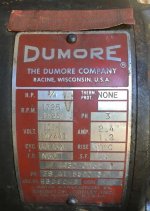I have a 3 phase motor that runs very slow, maybe 200 rpm, it's new to me and it's my first time using a VFD, all my other 3 phase equipment is run on a rotary converter, but thought I would try a VFD for a variety of reasons.
I tested the VFD on another motor and it works as it should, the slow motor runs smooth and quiet, it reverses, no response when changing the frequency, no smoke, buzzing, or heating, and it's wired for the correct voltage.
Any ideas what I should check?
I tested the VFD on another motor and it works as it should, the slow motor runs smooth and quiet, it reverses, no response when changing the frequency, no smoke, buzzing, or heating, and it's wired for the correct voltage.
Any ideas what I should check?


